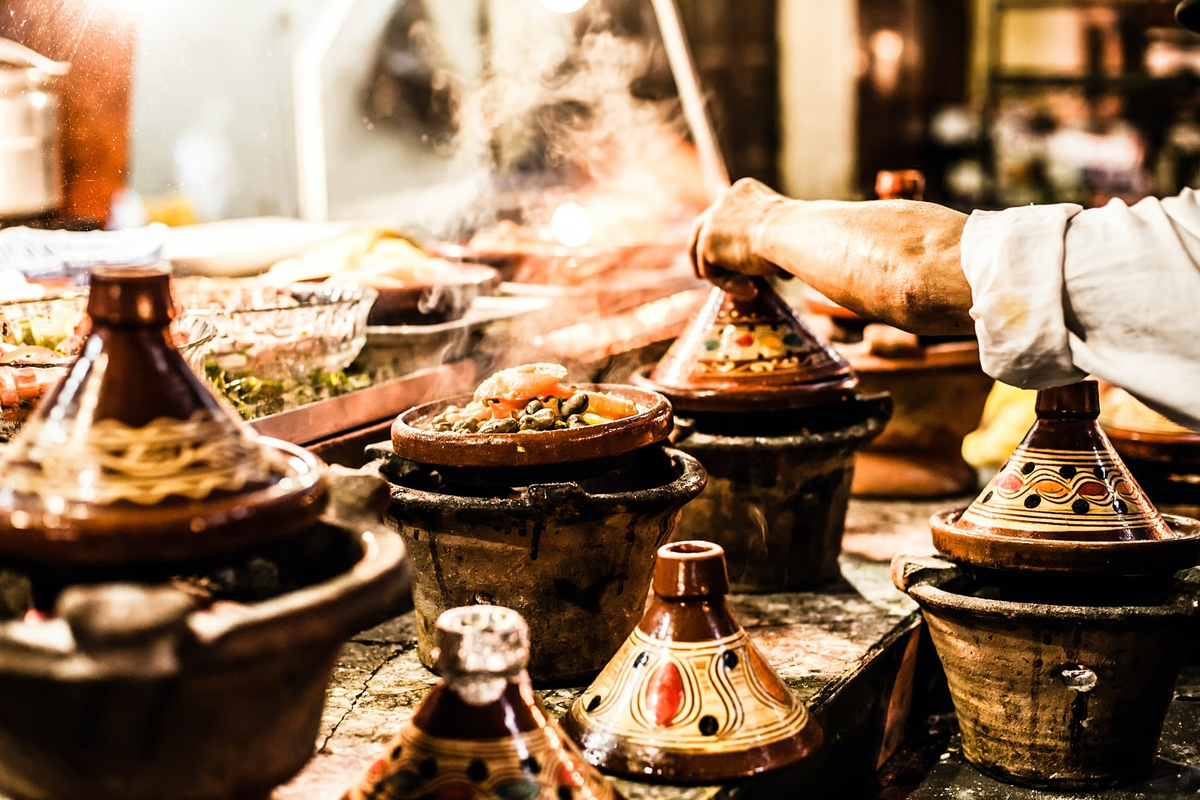
Moroccan cuisine is a vibrant celebration of history, culture, and fresh ingredients. From aromatic spices and slow‐cooked stews to intricate pastries and versatile side dishes, every dish tells a story. In this post, we explore top five traditional Moroccan recipes that capture the soul of the cuisine.
Whether you’re mastering an authentic Fes-style lamb tagine, creating a vegan twist on the hearty harira soup, perfecting a flaky pastilla, experimenting in a gluten‐free couscous workshop, or preparing festive treats for Ramadan and Eid, there’s a recipe here to inspire your next meal.
Fes, one of Morocco’s ancient cities, is known for its culinary heritage. A signature dish here is the lamb tagine—a slow‐cooked stew bursting with the rich flavours of North Africa. Traditional Fes‑style lamb tagine is prepared using tender lamb shoulder, marinated in a blend of warm spices such as cinnamon, cumin, ginger, and saffron, along with garlic and preserved lemon zest. Adding dried fruits like apricots or prunes and a handful of toasted almonds creates a beautiful balance of savoury and sweet.
Tips for the Perfect Lamb Tagine:
Harira is a beloved Moroccan soup traditionally served during Ramadan to break the fast. Known for its robust tomato base, lentils, and chickpeas, harira is nourishing and satisfying. For those following a plant-based diet, vegan adaptations of harira are both accessible and delicious. The key is using vegetable broth in place of meat stock and loading the soup with fresh herbs and spices.
Key Elements of Vegan Harira:
For an inspiring vegan version, visit One Arab Vegan’s Harira Soup, which shows how traditional techniques can be adapted to suit modern diets.
Pastilla (or bastilla) is a show-stopping Moroccan pie that contrasts savoury and sweet flavours in every bite. Traditionally filled with pigeon or chicken, almonds, and a delicate mix of spices, pastilla is wrapped in paper-thin, crispy pastry layers. Mastering pastilla requires patience and attention to detail, especially when handling the delicate dough.
Tips for Perfect Pastilla:
While traditional pastilla recipes can be complex, a careful approach and a bit of practice can yield a pastry that is light, flaky, and bursting with flavor.
Couscous is a staple side dish in Moroccan cuisine, often served with tagines and salads. Traditional couscous is made from wheat semolina, but gluten-free alternatives are rising in popularity. Many workshops now focus on creating gluten-free couscous using corn, rice, or quinoa flour. These workshops not only teach the technique but also explore how to adapt the texture and flavor of couscous without compromising on authenticity.
What to Expect in a Gluten-Free Couscous Workshop:
For more insights on gluten-free adaptations in Moroccan cooking, local culinary centers and online resources like Food Network’s Moroccan dishes section can be very helpful.
Moroccan cuisine shines during festive occasions like Ramadan and Eid. These periods call for recipes that are not only nourishing and filling but also celebratory in flavor and presentation. Many families prepare special dishes during Ramadan, such as harira soup to break the fast, hearty tagines, and sweet pastries for dessert.
Seasonal Favorites:
These seasonal recipes are more than just meals—they are part of the cultural fabric that brings families together during sacred times.
| Recipe | Key Ingredients | Dietary Adaptations | Occasion |
|---|---|---|---|
| Fes‑Style Lamb Tagine | Lamb shoulder, preserved lemon, dried fruits, nuts | Can be adapted to use chicken/beef | Everyday/festive meals |
| Vegan Harira Soup | Lentils, chickpeas, tomatoes, vegetable broth, spices | Naturally vegan & gluten-free | Ramadan/anytime |
| Flaky Pastilla (Pigeon Pie) | Pigeon (or chicken), almonds, phyllo or handmade pastry | Can substitute chicken for pigeon | Special occasions |
| Gluten‑Free Couscous | Gluten-free flours (corn, rice, quinoa), olive oil | Naturally gluten-free alternative | Workshops & side dish |
| Seasonal Ramadan/Eid Dishes | Harira, tagine, pastries, salads | Adaptable for vegetarian/vegan | Ramadan and Eid celebrations |
Traditional Moroccan recipes invite you to experience the art of slow cooking, the magic of spice blends, and the joy of sharing a meal with loved ones. Whether you’re savoring a hearty Fes‑style lamb tagine, enjoying a nourishing bowl of vegan harira soup, mastering the intricate technique of flaky pastilla, or discovering new ways to make gluten‑free couscous, each dish brings a slice of Morocco’s rich culinary heritage to your table.
These recipes offer not only a taste of Morocco but also a connection to its traditions. They remind us that food is an experience that unites family, culture, and history. The next time you prepare a Moroccan dish, you’ll be sharing more than just a meal—you’ll be sharing a piece of Morocco’s vibrant story.